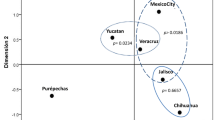Summary
Allele and genotype frequencies for British Caucasian, Afro-Caribbean and Asian populations were determined for a total of over 600 unrelated individuals at the HLA-DQα locus. These were analysed by polymerase chain reaction amplification of the DNA followed by hybridisation to allele specific oligonucleotide probes in a reversed dot-blot test. Six different alleles were detected and the allele distributions for the 3 populations analysed displayed significant differences. However, the British Caucasian genotypes were statistically very similar to previously published data from US Caucasians as were British Afro-Caribbean genotype frequencies with US Black data. In Caucasians the allele frequencies ranged from 5.2% to 26.9% with a power of discrimination of 0.93. DQα genotype frequencies of Caucasian and Afro-Caribbean populations do not deviate from Hardy-Weinberg equilibrium. However, the Asian data displayed significant deviation due to excess homozygotes.
Zusammenfassung
Die Allel- und Genotyp-Frequenzen am HLA-DQα Locus wurden für britische Europäder, Afro-Karibier und für asiatische Bevölkerungen an mehr als 600 unverwandten Personen bestimmt. Die Bestimmung erfolgte durch Amplifikation der DNA mit Hilfe der Polymerase-Kettenreaktion, gefolgt von einer Hybridisierung mit allelspezifischen Oligonucleotid-Sonden in einem umgekehrten „Dot-Blot”-Test. Sechs verschiedene Allele wurden nachgewiesen, und die Allel-Verteilungen für die drei untersuchten Bevölkerungen läßt signifikante Unterschiede erkennen. Jedoch waren die britisch-europdischen Genotypen statistisch sehr ähnlich zu früher veröffentlichten Daten von den US-Europädern, wie auch die britischen afrokaribischen GenotypFrequenzen zu den Daten der US-Schwarzen sehr ähnlich sind. Bei Europäern variierten die Allel-Frequenzen von 5,2% bis 26,9%, die Diskriminationsmöglichkeit betrdgt 0,93. Die DQα Genotyp-Frequenzen für europäi-sche und afrokaribische Populationen weichen nicht vom Hardy-Weinberg-Gleichgewicht ab. Jedoch zeigen die asiatischen Daten eine signifikante Abweichung, welche durch einen Überschuß an Homozygoten bedingt ist.
Similar content being viewed by others
References
Gill P, Jeffreys AJ, Werrett DJ (1985) Forensic application of DNA ‘Fingerprints’. Nature 318:577–579
Saiki RK, Bugawan GT, Horn GT, Mullis KB, Erlich HS (1986) Analysis of enzymatically amplified (3-globin and HLA DQα DNA with allele-specific oligonucleotide probes. Nature 324:163–166
Jeffreys AJ, Wilson V, Neumann R, Keyte J (1988) Amplification of human minisatellites by the polymerase chain reaction: towards DNA fingerprinting of single cells. Nucleic Acids Res 16:109053–10971
Horn GT, Richards B, Klinger KW (1989) Amplification of a highly polymorphic VNTR segment by the polymerase chain reaction. Nucleic Acids Res 17:2140
Wrischnik LA, Higuchi RG, Stoneking M, Erlich HA, Arnheim N, Wilson AC (1987) Length mutations in human mitochondrial DNA: direct sequencing of enzymatically amplified DNA. Nucleic Acids Res 15:529–542
Sullivan KM, Hopgood R, Lang B, Gill P (1991) Automated amplification and sequencing of human mitochondrial DNA. Electrophoresis 12:17–21
Reynoldsz R, Sensabaugh G, Blake E (1991) Analysis of genetic markers in forensic DNA samples using the polymerase chain reaction. Anal Chem 63:2–15
Bodmer JG, Marsh SGE, Parham P, Erlich HA, Albert E, Bodmer WF, Dupont B,Mach B, Mayr WR, Sasazuki T, Schreuder GM Th, Strominger JL, Svejgaard A, Terasaki PI (1990) Nomenclature for factors of the HLA system. Tissue Antigens 35:1–8
Erlich HA, Bugawan TL (1989) HLA class II gene polymorphism: DNA typing, evolution, and relationship to disease susceptibility. In: Erlich HA (ed) PCR technology, principles and applications for DNA amplification. Stockton Press, New York, pp 193–208
Higuchi R, Beroldingen CH von, Sensabaugh GF, Erlich HA (1988) DNA typing from single hairs. Nature 332:543–546
Li H, Gyllenstein UB, Cui X, Saiki R, Erlich HA, Arnheim N (1988) Amplification and analysis of DNA sequences in single human sperm and diploid cells. Nature 335:414–417
Westwood SA, Werrett DJ (1990) An evaluation of the polymerase chain reaction method for forensic applications. Forensic Sci Int 45:201–215
Saiki RK, Walsh PS, Levenson CH, Erlich HA (1989) Genetic analysis of amplified DNA with immobilised sequence-specific oligonucleotide probes. Proc Natl Acad Sci USA 86:6230–6234
Helmuth R, Fildes N, Blake E, Luce MC, Chimera J, Madej R, Gorodezky C, Stoneking M, Schmill N, Dliz W, Higuchi R, Erlich HA (1990) HLA-DQa allele and genotype frequencies in various human populations, determined using enzymatic amplification and oligonucleotide probes. Am J Hum Genet 47:515–523
Gill P, Sullivan KM, Werrett DJ (1990) The analysis of hypervariable profiles: problems associated with the objective determination of a match. Hum Genet 85:75–79
Nei M, Roychoudhury AK (1974) Sampling variances of heterozygosity and genetic distance. Genetics 76:379–390
Fisher RA (1951) Standard calculations for evaluating a blood group system. Heredity 5:95–102
Sokal RR, Rohlf FJ (1981) Biometry: the principles and practice of statistics in biological research, 2nd edn. Freeman, New York
Gyllensten UB, Erlich HA (1989) Ancient roots for polymorphism at the HLA-DQa locus in primates. Proc Natl Acad Sci USA 86:9986–9990
Comey CT, Budowle B (1991) Validation studies on the analysis of the HLA-DQa locus using the polymerase chain reaction. J Forensic Sci 36:1633–1648
Author information
Authors and Affiliations
Rights and permissions
About this article
Cite this article
Sullivan, K.M., Gill, P., Lingard, D. et al. Characterisation of HLA DQα for forensic purposes. Allele and genotype frequencies in British Caucasian, Afro-Caribbean and Asian populations. Int J Leg Med 105, 17–20 (1992). https://doi.org/10.1007/BF01371231
Received:
Revised:
Issue Date:
DOI: https://doi.org/10.1007/BF01371231



